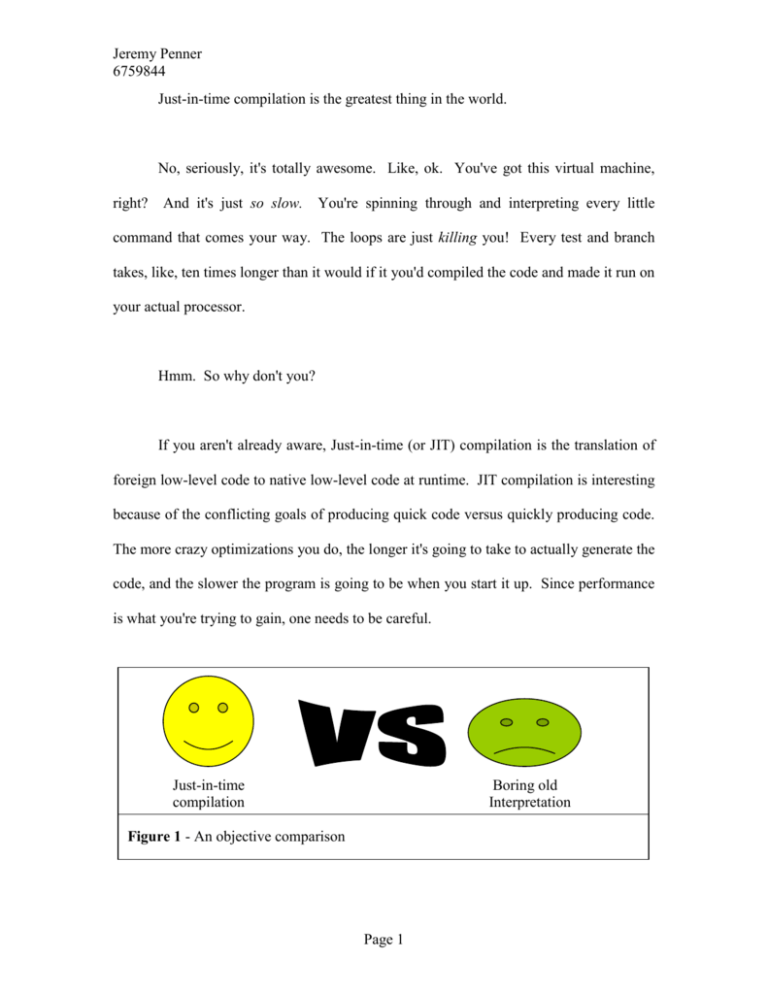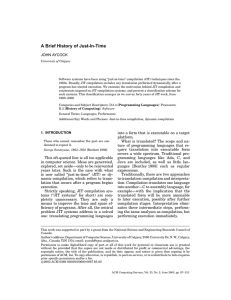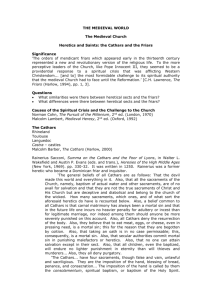the last paper of my undergraduate career
advertisement

Jeremy Penner 6759844 Just-in-time compilation is the greatest thing in the world. No, seriously, it's totally awesome. Like, ok. You've got this virtual machine, right? And it's just so slow. You're spinning through and interpreting every little command that comes your way. The loops are just killing you! Every test and branch takes, like, ten times longer than it would if it you'd compiled the code and made it run on your actual processor. Hmm. So why don't you? If you aren't already aware, Just-in-time (or JIT) compilation is the translation of foreign low-level code to native low-level code at runtime. JIT compilation is interesting because of the conflicting goals of producing quick code versus quickly producing code. The more crazy optimizations you do, the longer it's going to take to actually generate the code, and the slower the program is going to be when you start it up. Since performance is what you're trying to gain, one needs to be careful. Just-in-time compilation Boring old Interpretation Figure 1 - An objective comparison Page 1 Jeremy Penner 6759844 Can I just take this opportunity to assert that John Linnell (of They Might Be Giants) is the greatest songwriter of our time? Seriously, do yourself a favour and pick up State Songs. From the liner notes1: Too often identified only with its prodigious potato crop, [Idaho] has many surprises in store for the uninitiated. Her vast hydroelectric dams produce enough power to deep-fry each of her potatoes millions of times over. Idaho can also claim one of the world's deepest gorges, Hell's Canyon, a worthy serving bowl for such a feast of french fries! Here, Linnell is making a brilliant comment about our perception of JIT compilation -- namely, that while we may associate it with making our Java programs bearable, or with playing Super Mario 64 at full speed, it was a technique originally developed by hardware manufacturers in order to ease the transition from CISC to RISC architectures2. Basically, JIT compilation is a process of reverse-engineering the semantics of a program, and re-engineering the result back into binary code. The code is split up into blocks, some higher-level meaning is extracted from the current block of code, and native code is generated. The trick is, how high a level can the binary be analyzed to until the JIT compiler loses its performance gains? Page 2 renneP ymereJ 4489576 One might be tempted to statically analyze a program and output a native executable, bypassing all of this annoying runtime compilation crap. That is, until one remembers the Curse of Von Neumann3! Yes, since code and data can be haphazardly thrown together, there's simply no way to know for sure what is what. This is naturally less of a problem for, say, Java's bytecode, from which you can basically decompile it right back into the original Java source, if you like. As a consequence, most, if not all, JIT-enabled Java VMs give into this temptation, and do static JIT4. Tipping the balance in dynamic JIT's favour is the fact that one can do some interesting optimizations at runtime that, based on profiling results, are simply not possible with static binary translation. The runtime environment can keep track of the number of times each block has been executed; when a certain point has been reached, the block can be re-analyzed to a higher level, and further optimizations performed on it. In this way, time spent optimizing is only spent on sections of code which need it. Traditionally, a JIT compilation system is tightly coupled to the target processor. There has, however, been some interesting work in the field of portable JIT compilation systems. Firstly, there is the open-source GNU Lightning project5, which consists of a bunch of preprocessor macros which present a generic RISC-like system to the programmer, allowing them to generate machine code for several architectures effortlessly. On the other end of the lightweight/heavyweight spectrum, there is the system presented in David Ung's paper, Machine-Adaptable Dynamic Binary Translation2, in which the user provides the specifications for the binary formats, Page 76,493 Jeremy Penner 6759844 instruction set architectures, etc. used by both the original binary's processor and the host's processor. It contains a bunch of generic optimizations which allow it to generate reasonably fast code, reasonably quickly, without the programmer doing much of anything in the optimization department. In conclusion, I would like to take a moment here to relate to you the worst pun in the world. Here it is: Once upon a time, there were two friars who decided to open up a flower shop. They were a huge overnight success; everyone in town wanted to buy flowers from the men of the cloth. The other flower shop in town was not so pleased with this development. They went to the friars and asked politely that they close up shop, but the friars refused. They came back the next day and begged the friars to close, but still no dice. They got the friars' mother to come in and ask for them to close, but the friars would not be dissuaded. Finally, the rival florists convinced Hugh McTaggart, the roughest, toughest, meanest man in the whole town, to go and try and "persuade" the friars to close up shop. In he walks, upturning furniture, beating the poor friars to within an inch of their lives, screaming at them all the while to get out of town. Terrified, the friars close their shop and leave town. The moral of this story: Hugh, and only Hugh, can prevent florist friars. Thanks. I had to get that out of my system. 1 J. Linnell. State Songs, liner notes. 1999. D. Ung, C. Cifuentes. Machine-Adaptable Binary Translation. 2000. 3 Ibid. Seriously, wouldn't this be about the greatest name for a rock band ever? 2 Page 4 Jeremy Penner 6759844 4 A. Krall. Efficient JavaVM Just-in-Time Compilation. 1998. I don't have internet access right now, so just Google for "gnu lightning", it'll come up. It's a pretty cool system. 6 There is no rule 6. 5 Page 5











